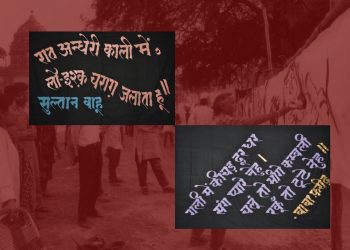Sahmat’s celebration of the “Bhakti-Sufi traditions,” the syncretic devotional practices that arguably span the divisions between Hindus and Muslims in everyday life, is an act of foregrounding of the tolerant, pluralistic, and inclusive traditions. Before the Babri Masjid was destroyed, Sahmat had planned a program of Sufi–Bhakti performances for January 1, 1993, titled Anhad Garje (a phrase used by the medieval saint-poet Kabir that roughly translates to “the silence reverberates”). In the immediate aftermath of the demolition, the seventeen-hour stretch of performances took on an additional resonance by promoting communal harmony and serving as a reminder of the power of performance to voice resistance.
Sufi-bhakti traditions embody a resistance against narrow orthodoxies, and a reflection of the secular and diverse fabric of the country.
Following this, Sahmat selected images by contemporary artists to accompany selected poetic verses from these traditions, and then these combinations were used to make a series of posters titled In Defense of Our Secular Tradition, of spreading their message of unity and introducing contemporary art to new audiences in an accessible format.




